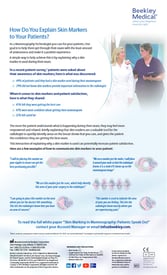
Keeping a patient informed during a medical procedure, although top of mind for many health care providers, may not always come as easily as some might think. The fear and/or anxiety a patient might feel going in for a mammogram may become exacerbated by their lack of knowledge of what to expect during the procedure (what devices or tools will be used) as well as what the results will be.
When a patient has a pleasant experience during their mammogram, it can encourage future mammograms and compliance with any follow-up care that may be required. Good communication with the patient can give the technologist an opportunity to educate the patient, alleviate fear or anxiety, and clarify misconceptions.
Patient survey reveals gaps in communication, missed opportunities
While most mammography technologists do take the time to explain the exam and the importance of compression, they may be missing an opportunity to improve patient perception and confidence in the quality of care they are receiving by not adequately explaining the use of skin markers and how they provide important information to the radiologist interpreting their images.
In March of 2021, a survey was conducted to just under 600 women between the ages of 40 and 80 across the United States who have had at least one mammogram. The purpose of the survey was to discover how patients perceive the use of skin markers during their mammogram as well as if they where even aware that skin markers had been used.
One of the major findings from this survey was that although 60% of respondents were aware that skin markers were used during their mammogram, nearly one third of those same respondents didn’t know why they where being used.
This leads into the next finding; that the explanations that technologists were providing to the patient were somewhat confusing.
Poor or incomplete communication can leave patients confused
61% of respondents reported that they understood the technologist’s explanation of why the skin markers in general were being used, however there was some misunderstanding when it came to all the different types of skin markers.

As you can see in the graph above, almost one third of respondents who had a nipple marker used on them said the technologist didn’t explain why it was being used. And despite receiving an explanation about why a mole marker was used; just under 20% of respondents were still confused as to why it was being used.
However, of those patients who understood why the technologist was using skin markers during their mammogram, the majority felt that they were receiving better care and a more accurate exam.

Clear understanding leads to improved confidence in the exam and care
In fact, not only was perception of care improved in patients who understood the value of skin marker use in mammography, 70% of those respondents felt that it was absolutely essential or very important that their breast imaging center use skin markers.

These survey results indicate that when patients understand the value of the tools used during their mammogram, their confidence in their care at your facility goes up, leading to better customer satisfaction and retention.
Since the mammography technologist is usually the only link between the patient and the radiologist, any information they do or do not convey makes a key difference in patient perception of care.
A helpful resource to help educate patients about mammography skin markers
The responses to this survey demonstrate an  opportunity for improving perception of care with a more thorough explanation of the purpose and importance of skin markers.
opportunity for improving perception of care with a more thorough explanation of the purpose and importance of skin markers.
To help your technologists better explain the use of skin markers to your patients, Beekley Medical put together this helpful resource as a result of this survey. Click on the image below to download it now.
To learn more about the benefits of mammography skin makers, visit the breast health section on beekley.com or contact your Beekley Medical Account Manager at 1.800.233.5539.

Megan Sargalski
Marketing Communications Specialist
